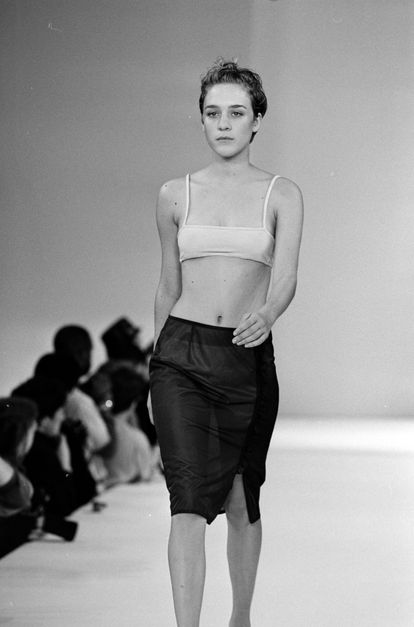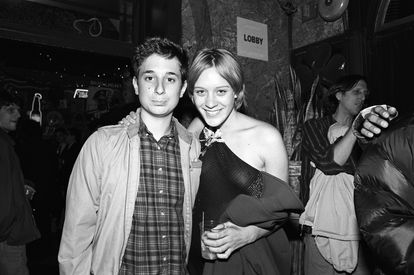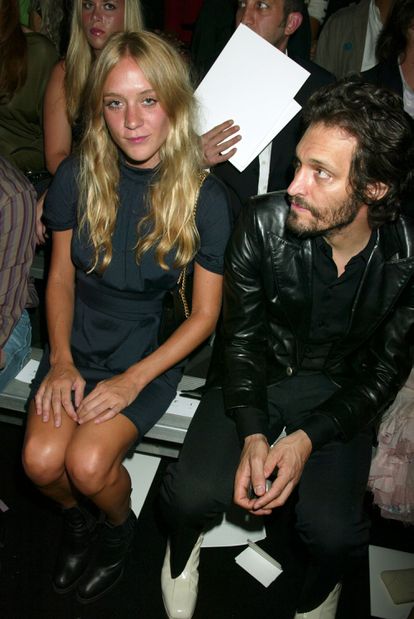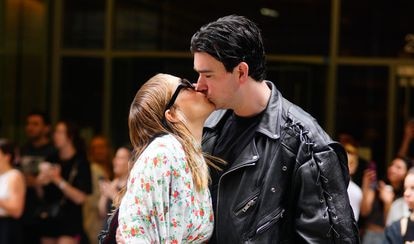Most of those who saw Chloë Sevigny in Kids (1995) believed that she was a street girl with no future. Those who saw her fighting loudly with her boyfriend (Harmony Korine) probably thought that she would have a short and unstable career. And then, years later, when she performed fellatio on Vincent Gallo in The Brown Bunny (2003), those who were scandalized assumed that Hollywood would close its doors on her once and for all.
However — to the surprise of those who jumped to conclusions — in 2023, Sevigny not only has a career, she has a thriving one. She has worked with some of the most interesting contemporary directors, such as Lars von Trier, Woody Allen, David Fincher or Jim Jarmusch, and is an icon of fashion, having modelled for some of the best designers in the world. And now, she’s succeeding with the TV series Poker Face, where she plays a wild singer from a one-hit band who ekes out a living working in a warehouse. Her magnetic performance shows how she has managed to achieve one of the most fascinating and unorthodox careers in the industry.
Her role in Kids was supposed to be a minor one: she was going to play a girl who kisses another girl in a pool. But, three days before filming began, Mia Kirshner — the actress who was supposed to play the role of Jennie — was fired. Her problem, apparently, was that she appeared too professional: she resembled an actress in the middle of a cast made up of real street kids. Screenwriter Korine, a close friend of Sevigny, suggested her as a replacement. Director Larry Clark accepted. Even though she had never acted before, her character became the backbone of the film. At the age of 19, she played a 14-year-old girl who discovers that she is HIV positive. She wanders throughout the film looking for the guy who infected her and ends up being raped while unconscious.


“I asked for a day to think about it and I said to myself: ‘fuck it, I’ll do it.’ When I was a kid, I did theater every summer. I wanted to be an actress,” she confessed to Ingrid Sischy in Interview Magazine. When the production team asked where they could find her, she told them that she slept in a different place every day. That was her life back then: partying all night in trendy clubs and waking up at a friend’s house. The producers gave her a pager so that she could call the driver and tell him where she was so that he could pick her up.
Her performance was so natural that many believed that Jennie’s life was really hers. “People would come up and hug me — they thought that [all the things that happened in the movie] had really happened to me. There were kids who cried and told me: ‘I have HIV too.’ I was happy about the impact the film had… but I also discovered what it meant to be a public figure and give up your anonymity.” Critics were divided between those who considered Kids to be a masterpiece and those who only saw the pornographic element in the film. Regardless, they unanimously applauded Sevigny’s performance.
Chloë Sevigny (the umlaut in her name is her addition, as she thought it was elegant) grew up in Darien, a wealthy suburb of Connecticut, where her father was an art teacher. But every weekend, she went to New York and spent hours in Washington Square Park with the skaters that Kids would end up immortalizing. Her style — made up of clothes that usually cost her no more than a couple of dollars — was so original that the editor of the now-defunct teen magazine Sassy approached her on the street and asked her to participate in an advertising campaign. She ended up working at the magazine and spending her days at Liquid Sky, a clothing and record store, which became a meeting place for the city’s young and trendy people. Her unique image also led her to star in a Sonic Youth music video and to be one of the muses of X-Girl, the clothing brand belonging to the group’s bassist, Kim Gordon.
Jay McInerney dedicated a long profile to her in The New Yorker, in which he referred to her as “the coolest girl in New York.” She reluctantly accepted the title, in exchange for getting a pink latex Helmut Lang dress. Without searching for fame, she had become an icon of the emerging hipster culture that was beginning to take shape in New York. As Sischy wrote in Interview, “Sevigny isn’t sure she wants to be famous, but fame desperately needs her.”
The overwhelming response to Kids led her to take refuge in a small film called Trees Lounge (1996), the directorial debut of Steve Buscemi, starring Samuel L. Jackson and Mimi Rogers. This is where she discovered that she didn’t want to be a star, but rather, a character actress.
Excess fame overwhelmed her — she was familiar with its consequences during her relationship with musician Jarvis Cocker, the frontman for Pulp. At the time, he was one of the most famous men in the United Kingdom.


David McNew (Getty Images)
“We were driving through remote towns in Wales and kids were chasing us down the street. I thought: ‘This is horrible!’ I saw the effect it had on him and decided I never wanted to be a celebrity on that level. I think that’s why I’ve chosen to do the work I do, to work with directors I like and who mean something to me,” she once told The Guardian. In the unclassifiable movie Gummo (1997), Harmony Korine’s directorial debut, she was able to combine her two universes: fashion and acting. She was the film’s costume designer and the female protagonist. It was another independent filmmaker — Whit Stillman, a dandy totally removed from Korine’s ragged nihilism — who gave her a more elegant role in The Last Days of Disco (1998).
At the time of filming, Kimberly Peirce was closing the casting of Boys Don’t Cry (1999): the story about a transgender man named Brandon Teena, who was raped and murdered in Nebraska. While watching The Last Days of Disco, she fell in love with Sevigny’s character and her unmistakable eyes. Sevigny wanted the leading role that Hilary Swank would end up playing (she ultimately won the Oscar for it), but the director didn’t see an ounce of masculinity in her. Instead, she convinced Sevigny to accept the role that she considered most important: Brandon’s girlfriend, Lana Tisdel. In addition to winning an Independent Spirit Award for her performance, she was also nominated for an Academy Award for Best Supporting Actress. Angelina Jolie ultimately won, for Girl, Interrupted.
“It was very competitive,” she told The Guardian in 2008, in what seemed like a tantrum. “Besides, Angelina Jolie’s role wasn’t a supporting one.” This is one of Sevigny’s many contradictions: she doesn’t care about the movie industry, and yet, she would have liked to have won the Oscar. She doesn’t want to make commercial films — she turned down $500,000 for the role of Selma Blair in Legally Blonde — but, at the same time, she regrets having missed out on roles in Mona Lisa Smile (2003) or Mr. & Mrs. Smith (2005). She’s also had a hard time bending to industry norms. “An agent once told me that, in an audition, I had to make women want to be me and men want to fuck me,” she confessed to Esquire. “I said, ‘I’m sorry, that’s not my motivation in life.’”

Her career is full of unconventional titles, such as American Psycho (2000) or Dogville (2003). But nothing went more astray from Hollywood standards than The Brown Bunny (2003). Vincent Gallo wrote it, directed it and starred in it. During its screening at the Cannes Film Festival, the audience was divided between those who left the room and those who booed it. “I once had a colonoscopy and they let me see it on a screen. It was more entertaining than watching The Brown Bunny,” wrote film critic Roger Ebert. However, what filled the news after the premiere weren’t the long shots that bored reviewers, but the unsimulated fellatio that Sevigny performed on the protagonist. She considers the reaction to have been excessive — what she did was simply part of her acting job.
“If you’re not challenging yourself and taking risks, then what’s the point of being an artist?” she asked rhetorically, in an interview with The Times. “It’s a very intense romantic scene, very beautiful. It’s not gratuitous, it’s deep. I thought about it and had some concerns, but I know the way Vincent works and I trusted him completely. It’s something I do in my everyday life: everyone has done it, or has had it done to them. It was the most difficult role I’ve ever played, but Vincent was very sensitive to my needs, he was very kind. [The take] was a funny and awkward moment… we both laughed a lot. We’d been a little intimate in the past, so it wasn’t that strange. I agreed to do it for the movie. I knew I was going to do it, and I did it: that’s all there is to it.”
There were many who thought that her career was dead after that scene. Few actresses have survived explicit sex scenes. And, back in 2003, online porn and the Onlyfans phenomenon still weren’t the daily bread of celebrities. But the truth is that her career didn’t suffer. In fact, after The Brown Bunny, Sevigny was offered even more films than ever before. She was in Melinda and Melinda (2004), directed by Woody Allen, and Zodiac (2007), by David Fincher, which was her first film with a major studio.

Her most lucrative role also came up around this time: for five seasons, she was one of the three wives of a Mormon leader in Big Love (2006-2011), one of HBO’s gems. She won a Golden Globe for her performance, while also realizing that television can offer more interesting roles than cinema. Since Big Love, she’s been part of the troupe in American Horror Story (2011-present), played a trans assassin in the miniseries Hit and Miss (2012) and portrayed the mother of her friend, Natasha Lyonne, in Russian Doll.
Throughout her career, Sevigny has appeared more in fashion magazines than in film magazines. Designers and stylists have been attracted to her unique style, which has made her a fixture on best and worst-dressed lists. “The fashion world is fascinated by her, because she isn’t only talented, young and attractive, but she stands out in a sea of actresses who often have a typical look,” wrote designer Marc Jacobs. Sevigny has often been one of his muses. “Fashion is a good way to make a living,” she opined. “I couldn’t survive just making independent films. I prefer to be a model than to do movies or series that I don’t like.”
Her life changed during the pandemic: she married Croatian gallery owner Siniša Mačković and had a son. Her day-to-day is now more relaxed. She’s aware that her phone doesn’t ring as much as other actresses’, but she doesn’t really mind. Currently, she’s excitedly researching her next project: the second season of Feud, which is based on Laurence Leamer’s book, Capote’s Women: A True Story of Love, Betrayal, and a Swan Song for an Era. She will play the elegant socialite C.Z. Guest, one of the women who, in the words of Capote, “wasn’t born rich, but was born to be rich.” It’s a role that seems perfectly written for the woman who was once called “the coolest girl in New York” when she still didn’t have a regular place to sleep.
Sign up for our weekly newsletter to get more English-language news coverage from EL PAÍS USA Edition
This post was originally published on this site be sure to check out more of their content.








